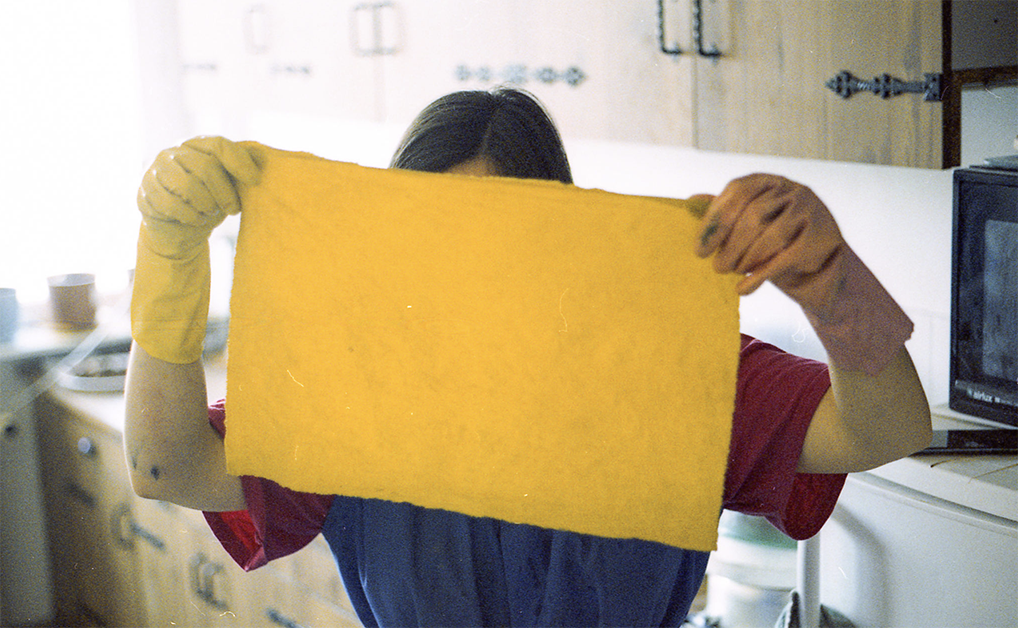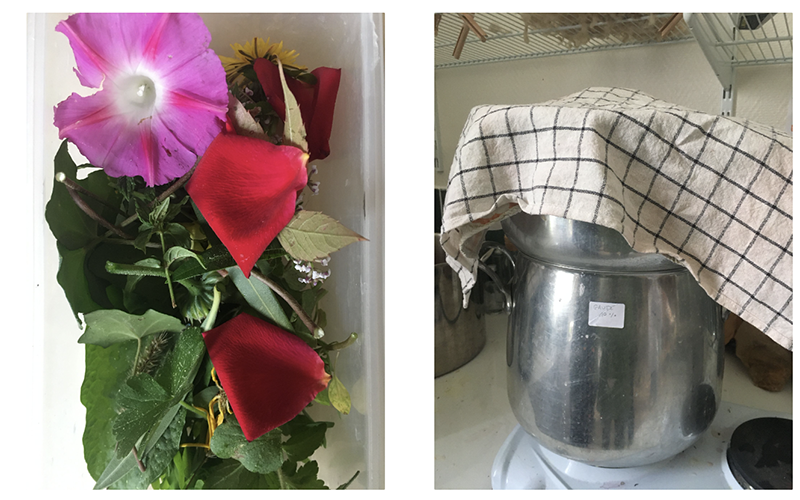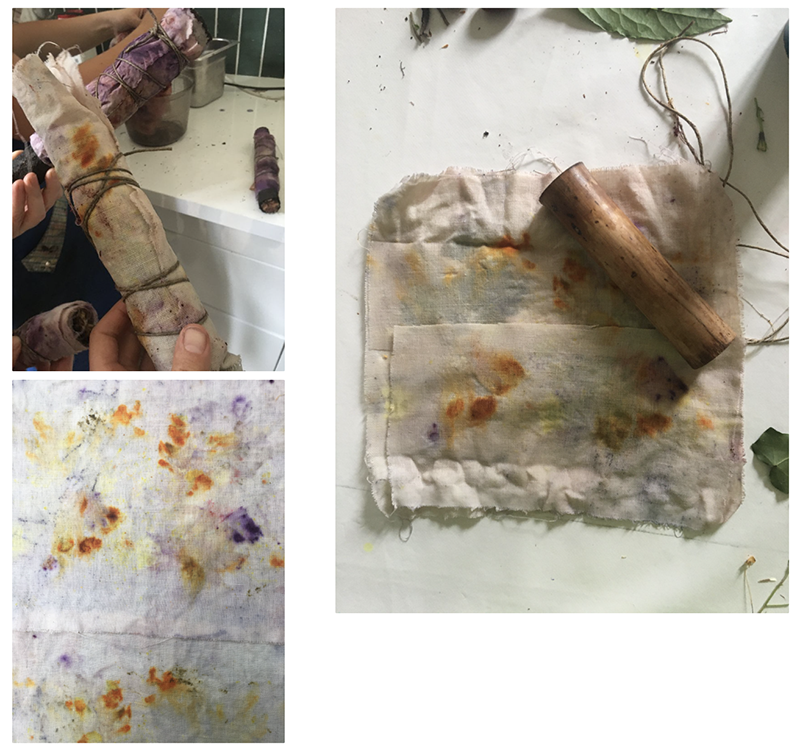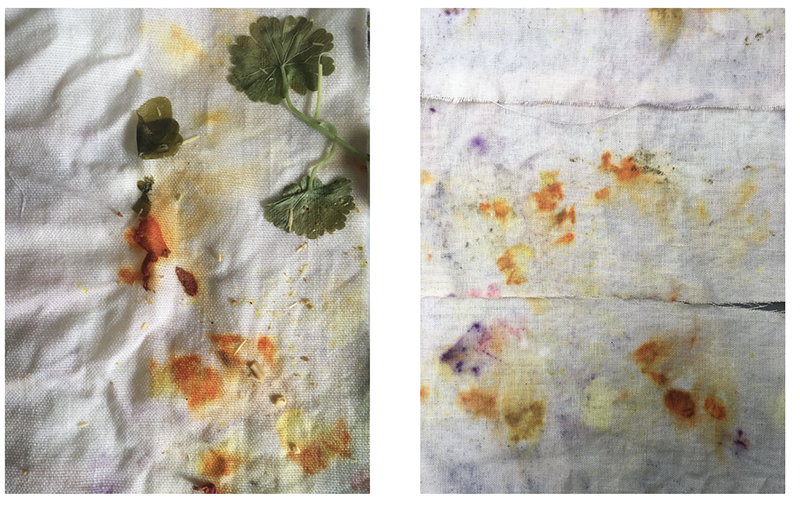4∙ BioChromes¶
11th to 18th October 2022
Update
- October, 2022
- November, 2022
- April, 2023
Assignments
- Produce at least one natural dye or bacterial dye:
- Natural dye: modifying it’s colour and mordanting it in different ways to dye at least 2 different categories of fibers
- Bacterial dye: Explored dyeing with bacteria of different fibers and/or bacteria
- Produce at least one botanical or bacterial ink:
- Botanical Ink: explore different materials, recipes and understand how to adjust them based on the ingredients
- Bacterial Ink: explore bacteria solvents and understand how to adjust or use the inks
- Document your recipes, the ingredients and process and if there have been changes, document your unexpected discoveries
- Name your materials, classify them by typology and display them in a systematic order of samples
Ressources of the week
Research & Ideation¶
This new week is dedicated about colors! More precisely about Biochromes.
Biochromes are any pigment produced by a living organism.
We had first the courses of Cecilia Raspanti. was nice to see and start to understand the history of the color, the natural color sources ( organic and inorganic), the multitude of the applications and the differents forms of how it’is possible to make Biochromes. She explain how we make inks, dye and pigments. Crazy how the knowledge about it, it’s starting to open a new door in my mind. I was really curious about how bacterial will be able to make a dying.


Ressources about the courses
For this week in the lab we was really lucky to have an expert of the natural plant dyer.
Charlotte of the brand Marga. She is graphist, serigraph and she made her proper brand, a collection made by upcycling fabric and organic dying . She use inks plant until the past 5 years.
She live in Annecy, she is really near of agricultor for growing or helping them to collect his plants.

I love her engagement and the philosophy of her work.
Charlotte start to teach them a global review about plant and what we will do during this future days.
The dying plant are using in general for the fabric, cosmetic and hair but this kind of inks doesn’t work for the pottery. We call this tinctorial plant. Tinctorial plant is plant they made a solid color and not be going ephemeral. There are 3 more stable plant : madder, reseda, marigold. In tinctorial plant we have 3 primary color : red with madder, yellow for reseda and indigo made by many different plants, it will be depend where you live. Japan is the best country and having an amazing culture of Indigo.
During this next days we will be focusing about fabric dying, inks, serigraphie, eco print and pigments. Obviously the bacteries dosent work yet.
Inspirations¶
I was really impatience to this week for discover more about bacterial dye. I never hear about it before discover Fabricademy.
Charlotte Luzia Werth¶
is a material designer working between textile- and biodesign.

Dianjen Lin¶
is a designer with 6 years of professional experience across costume/fashion design, photography, art and silver metalwork. Born and raised in the Taiwanese countryside, she has an innate awareness of the symbiosis between humanity and nature. She is particularly interested in science, technology and ecological ethics. She make Post Carbon Fashion, Regenerative Sustainability Activism.

Some Alumni's pages
- Beatriz Sandini TextileLab Amsterdam 2019-20_
- Kate Reed Dassault Systems 2020-21
- Petra Garaiová FabTextiles Barcelona 2021-22_
- Olatz Pereda Basque Design Center 2021-22_
We made all pictures, process and the most of informations are share by Charlotte Julien, Diane Wakim and made in group of the Fabricademy 2022-2023 in the textile lab in Lyon.
Fabric Dying¶
 For starting all this process we will be focus and determined the raw materials we will use for the experimentation.
For starting all this process we will be focus and determined the raw materials we will use for the experimentation.
In France we have a lot of wool and linen mostly.
Note : Burn the yarn with a lighter: a burnt horn smell is characteristic of animal fibers, while a burnt paper smell indicates cellulose fibers. If the yarn melts and curls, it is a synthetic yarn. Identification of blended and man-made fibers is more difficult: it is always best to test before dyeing.
The fibers of animal origin are of protein nature: silk,wool, alpaca, angora, mohair, cashmere, hair of all animals, etc. They can suffer from the excessive use of iron sulfate which makes them brittle and rough.
But if we use substantive plant, like rhubarb root (yellow), rumex (yellow), eucalyptus (orange) who have oxalic acid, we don't need mordanting for animal fibers because the oxalic acid binds to protein in the fibers. This is only for animal fibers.
- Animal fiber
- Alum
- Cream of tartar (potassium bitartrate)
- Thermometer
- Big pot
- Balance
The fibers of vegetable origin are of cellulosic nature: flax, hemp, ramie, cotton, raffia, etc.
Their mordanting will be done in several steps, because they do not cling as well to the molecules of the of the mordant and the dye. Tannins will be used to improve their improve their color adhesion.
They support very well dyes using iron as a mordant or additive, with which we will obtain with which one will obtain "solid" results. With cellulose fibers cellulose fibers, one can go up to 90°C and maintain them for one hour at this one hour at this temperature.
It’s possible to use just tanin but the result of the color is not the best.
- Cellulosic fiber
- Alum
- Oak gall extract
- Cream of tartar (potassium bitartrate)
- Thermometer
- Big pot
- Balance

This action is really helpful for cleaning wax, impureties of our fabric. The best is made with ecological soap : use Marseille soap or cender laundry. Wash your fabric mimum one times.
Laundry recipe with cender of oak ash: Collect oak wood, Make a fire, Keep the cender, Put it with water during 12h, Wait ! Make a filter, keep the liquid part.
Now your are the ecological laudry with cender, ready for clean your fabric.
Oak wood is the best, she has a lot of tannins but it doesn't dye.
1- Weigh the material dry (100% basis)
2- Wash the fabric: to remove the primers
🥽 If the fabric is dry, remember to moisten it so that the solution is deposited evenly.

The mordants are essential for all "non-substantive" dyes, those that do not naturally bind with the fiber, which is the case for the of the vast majority of them.
No mordant = no color in long term almost.
We have to take in consideration of this point about :
- our fabric
- the plant we use or the color we want
For choosing the best mordantly.
Mordant with mineral salt
- alun de potassium
- sulfate de fer :
- Acetate de fer : possible to make it with a nail soup.
- copper sulfate
- cream of tartar
- Is using for changing your water of the bath if it’s too much calcaire.
- oxalate de titane
Natural mordant
- Tannin with galls
Beware of thermal shock for wool! You need to gradually raise the temperature and also gradually lower it. Let the wool cool gently in the bath before rinsing. The wool tends to felts.
Mix with a large volume of water:
- +20 to 30% of the total weight of the fiber in potassium alum (powder)
- +5% cream of tartar (potassium bitartrate)
-
Step 1 - Put in Bath 1 at 70° for a minimum of 1 hour Mix the fabrics well to avoid streaks.
-
Step 2 - Cool gently leaving the fibers in the pan
-
Step 3 - Remove the fibers from the bath by gently wringing them out
-
Step 4 - Rinse lightly
-
Step 5 - Dry
🥽 The amount of water does not matter. The fabric must be able to move freely in the pan, add water if necessary.
- 10% oak gall extract by weight of the material.
Mix with a large volume of water:
- +20 to 30% of the total weight of the fiber in potassium alum (powder)
- +5% cream of tartar (potassium bitartrate)
🥽 The amount of water does not matter. The fabric must be able to move freely in the pan, add water if necessary.
-
Step 1 - Put in Bath 1 at 70° for a minimum of 1 hour Mix the fabrics well to avoid streaks.
-
Step 2 - Cool gently leaving the fibers in the pan
-
Step 3 - Remove the fibers from the bath by gently wringing them out
-
Step 4 - Rinse lightly
-
Step 5 - Dry
-
Step 6 - Place in Bath 2- Alum at 70°, for a minimum of 1 hour
-
Step 7 - Remove the fibers from the bath by gently wringing them out
-
Step 8 - Rinse the fibers with clear water
-
Step 9 - Dry
⚠️ Some dyers make several baths (Engallage, Alunage, Engallage, Alunage...) before coloring their fibers. The drying allows the incrustation in the fibers.
💡 Alunage = best coloration. Engallage = best solidity.
A dyer's ideal life Dyeing: in Autumn and Spring. and harvest the rest of the year. Very hot in summer for dyeing not recommanded.
🥽 If dry tissue, remember to moisten it so that the solution is deposited evenly.

It’s mean when we buy a natural dyed garment, we have the right to demand that the dye is resistant to light, washing, rubbing and if possible to sweat... If the dye resists to these different tests, we can say that it is great dyed.
In France, in 1634, a regulation of Colbert defines a very strict list of dyeing materials which will be respected during several centuries.
Colbert made a referencement of the color plant in fonction of them solidity.
During this days we made different bath of colors.
Dye plants
Previously mordanted fabrics
Water
Pots and pans
Hot plate
Spoons
1- Fill a pan with water
2- Add the quantity of plant in relation to the desired concentration in relation to the weight of the fabric
3- Put the pan to heat
4 - Stir regularly
5- Place the wet fabric in the pan
6- Raise the temperature very, very slowly to reveal all the coloring molecules
Rise to 80°.
7 - Stir regularly for a homogeneous coloring
Madder: put the fiber directly into the water+plant mixture and then gradually heat the whole. (**cold extraction)**
For the other plants : make a water+plant decoction to make a **hot extraction**.
Results¶

Silkscreen with natural inks¶
 Screen printing is a printing process created by the Chinese.
Screen printing is a printing process created by the Chinese.
The technique of screen printing can be broken down into 3 stages: the typon, the exposure and the printing.
Originally the screen was made of silk, today it can be made of polyester.
The canvas is coated with a photosensitive product that allows after exposure to the ink to pass only on the exposed surface. Screen printing is widely used for its resistance and ease of realization.
For this technique the printing is almost the time did by chemical inks. In this case Charlotte teach us how is possible to use it with natural inks.
Vinegar
Alumina sulfate
Iron sulfate
Guar gum powder
Soda crystals
Spoons
Beakers
Maryse
Bowls
Pre-insulated screen printing frame
Squeegee
Iron or alum printing paste
Color juice from dye bath
Step 1- Paste of printing¶
It is made with iron acetate or alumina. Never mix the two. Clean boards thoroughly after use.
200ml of 10/12% vinegar (the higher the acidity, the better)
12g alumina sulfate
10g soda crystals
Guar gum powder
200ml of 10/12% vinegar (the higher the acidity, the better)
12g iron sulfate
10g soda crystals
Guar gum powder
Measure
Add slowly vinegar + Iron sulfate or Alumina + soda crystals in beaker
Mix well, no lumps should remain.
Gradually add guar gum according to the desired texture. The texture of honey should be achieved. Mix well while adding pinches of gum.
Keep for up to a week, preferably in the fridge.
⚠️ Follow the order of ingredients. Add soda crystals in small quantities to the mixture. Watch out for the acid-base reaction - it foams!
Step 2- Printing¶
There's no need to bite the fabric, as the bite is in the printing paste.
1 - Position the fabric under the frame
2- Spread the paste on the screen-printing frame where you wish to print it. Use the squeegee to work the paste through.
3- Air dry (can be accelerated with a hair dryer).
4- Soak fabric in wheat bran ideally.
5- Soak in color bath
6- Dry in the shade!
⚠️ Beware of multiple dips, do not mix different baths.

After we made our bath of the color this it will be use for making a reaction with the acetate during the printing.
Acetate will be use like a mordant, we dont need to do mordanting of our fabric.

Results¶



Inks¶
For making natural inks for paper or other supports we have to mix the same quantity of acetate and natural inks of the bath of color.
50g alum or iron acetate
50g dye liquid
Thickeners :
Guar gum
Waxes
Gelatin
Rice flour
Or any other thickener
Beaker
Scales
Mixer
When inks are used on textiles you need to steam 1h to fix them. Inks are less solid / less resistant than printing paste.

Pigments¶


Diane Wakim explain to us how is possible to transform inks to pigments. This pigments are made with our bath of color too.
20g alum
5g soda crystals
200ml filtered coloured juice
3 beakers with high rims (the reaction may foam afterwards)
3 spoons
1 funnel
1 mortar and pestle
1 maryse
1 balance
1 piece of cotton to filter the pigment
1 dehydrator
⚠️ Do not mix the spoons as you go. The amount of water depends on the saturation of the alum as you mix.

1 - Weigh the solid ingredients: alum and soda crystals.
2- Dilute them separately with very hot water (Alum needs more time to dissolve)
3- Pour 200ml of filtered coloured juice into the high rim beaker
4 - Add the diluted alum to the beaker
5- Gently add the soda crystals and mix
6- Leave to stand for several hours, until 2 phases appear (a liquid and a solid phase)
7- Place the cotton ball in the funnel to recover the solid phase
8- Leave to filter for several hours/days
9- Collect the precipitate (solid phase) with a clean spoon
10- Put in a dehydrator
11- Grind it with a mortar and pestle
📎 Long conservation of the pigment in a hermetic support. Pigments dissolve in oil and not water.
Oil paint¶
- Mix a pile of pigment with small drops of linseed oil.
- Work the paste
Eco Print¶



Result of the week¶
The recycling of dye waste has marked me by the possibility of being able to start from a plant / root and use it in a multitude of applications. The dye becomes ink then pigment. The dye water and plants can be composted.
In the future experience I would like to try to dye some of my realization in knitting. How it can react if I mix different type of fabric in thread.
Aswell how is possible to make a paste for painting a canvas with pigments and inserate inside biomaterio.
Using bacteria dying is something I really want to try.